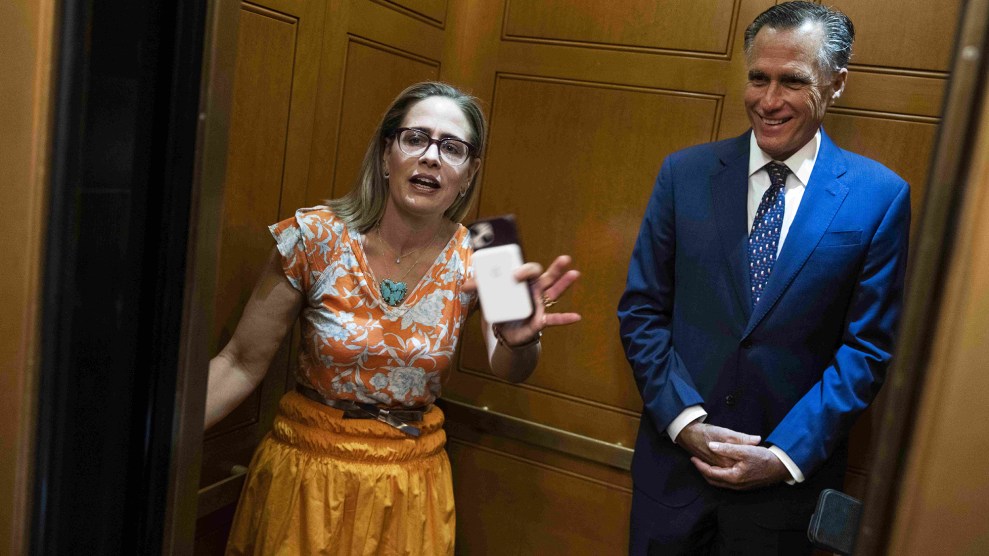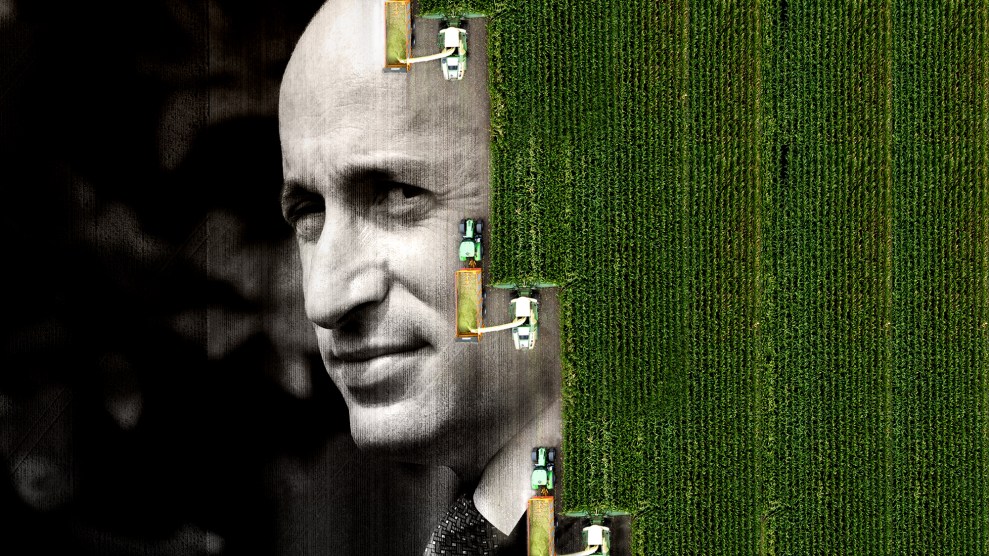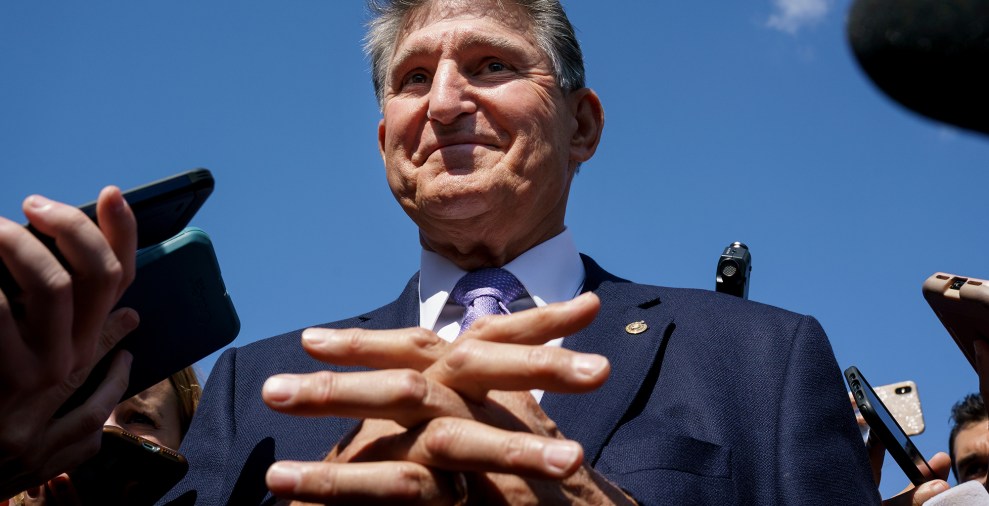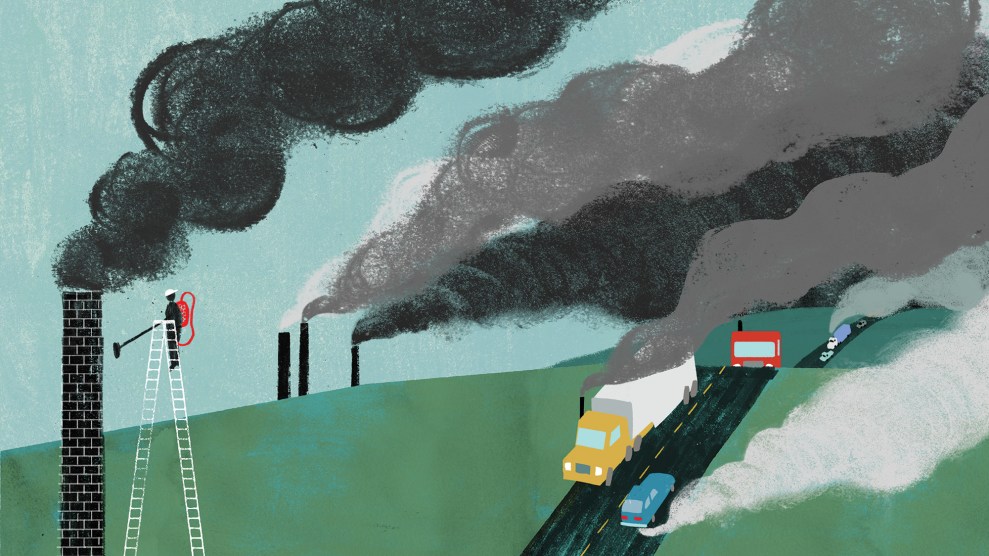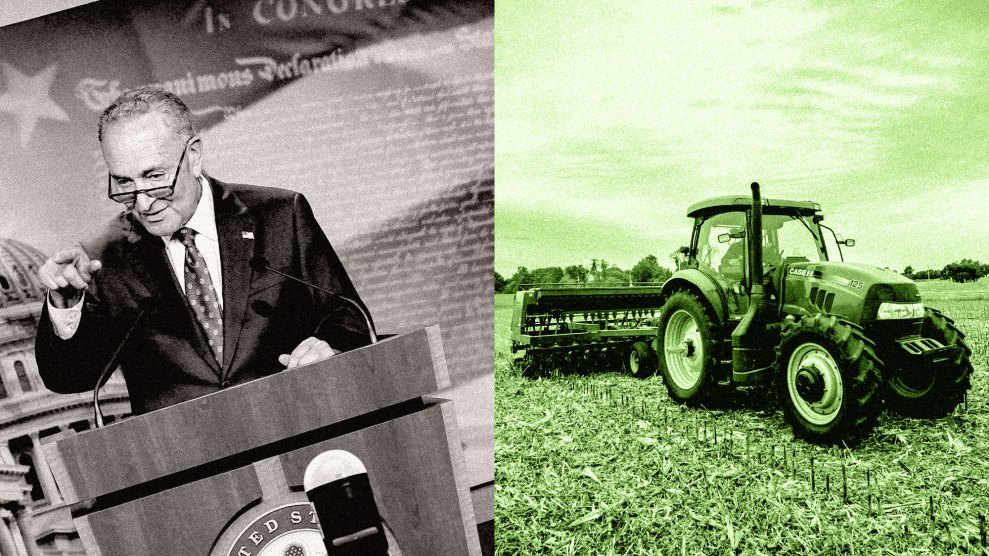
Mother Jones illustration; Shuran Huang/The Washington Post/Getty; Edwin Remsburg/VW Pics/Getty
The Inflation Reduction Act of 2022, whose Senate passage makes its enactment likely, contains a multitude of provisions. It’s the “biggest climate bill that any country has ever passed,” gushed Sen. Brian Schatz (D-Hawaii), lauding the bill’s $369 billion investment in clean energy. The act includes language that could reduce prescription-drug costs for as many as 48 million Americans. It narrows (with notable exceptions) the ability of some of the nation’s most profitable companies to avoid taxes—though hedge fund and private equity barons get to keep their lucrative carried interest loophole. And, to the chagrin of environmentalists, it offers a raft of goodies for the fossil fuel industry, wrung out of negotiations by Sen. Joe Manchin (D-W.Va.), who moonlights as a coal baron. (As a result, the bill “recognizes that natural gas and oil are an important part of the energy transition, and they’re going to be here for decades,” ConocoPhillips CEO Ryan Lance noted approvingly.)
But this sprawling new legislation also affects food and agriculture—which is my beat. So here’s my summary of the good, the bad, and the ugly of the act’s food-related provisions.
The good. The legislation, as it stands, injects $20 billion over 10 years into existing conservation programs administered by the Department of Agriculture. The biggest winner is the Conservation Stewardship Program, which helps farmers defray costs for implementing practices like cover crops to keep soil and fertilizer in place over the winter; buffer strips that prevent severe soil erosion from storms; and hedgerows as habitat for wild bees and other beneficial insects. For years, demand from farmers for CSP grants has overwhelmed the congressional funding available for it. Over the next four years, the IRA will add $3.5 billion annually to the CRP’s current $1.8 billion budget—a massive expansion.
The $20 billion ag-conservation outlay is a “big investment, the largest since the Dust Bowl of the 1930s,” Karen Perry Stillerman, deputy director in the Food and Environment Program at the Union of Concerned Scientists, wrote in a blog post. “And it’s climate-focused at a time when climate impacts on the nation’s farms and communities—from drought in California and its Central Valley to the horrific flooding in Kentucky—are becoming dire.”
Thanks to a last-minute push by Sens. Cory Booker (D-N.J.) and Raphael Warnock (D-Ga.), the bill also contains $3.1 billion in relief for farmers whose “agricultural operations are at financial risk” because of USDA-backed loans, and $2.2 billion in financial assistance for farmers who can show they’ve “experienced discrimination” in accessing USDA agricultural lending programs. These provisions are a response to the long history of racism at the USDA, which has driven a massive loss of land among Black farmers over the past century. In the 2021 American Rescue Plan, Congress addressed this long-simmering injustice by allotting $4 billion to erase the debt of thousands of farmers of color with outstanding USDA-backed loans.
A barrage of lawsuits from right-wing groups charged that the program represented unconstitutional “discriminatory racial preferences” by singling out Black farmers. Several federal judges bought that logic, and the USDA froze the payments last June. The IRA’s removal of specific racial framing for the aid will make it less vulnerable to such challenges.
Black farmers are “going to have to do some paperwork to document the discrimination that occurred, but we can work through that,” Lloyd Wright, a retired farmer and former director of the USDA’s Office of Civil Rights, told Civil Eats’ Lisa Held. “I think it’s really going to help the Black community.”
“I am excited that the Inflation Reduction Act clarifies and reappropriates this funding from the American Rescue Plan,” Sen. Booker told Mother Jones. “By giving USDA the authority to modify debt for distressed borrowers, we will keep family farmers around the country on their farms. For those farmers, particularly Black farmers, who have suffered USDA discrimination, this legislation sets in motion a process to right those wrongs.”
The bad. As I wrote in my book, Perilous Bounty, climate change is ravaging America’s Midwest, one of the world’s most productive farming regions. The Corn Belt, as it’s known, is dominated by just two crops, corn and soybeans, which are both harvested in the fall, leaving the ground bare until the spring planting. This leaves the soil vulnerable to fierce storms, ramped up by warming temperatures in the Gulf of Mexico, that pummel the region during the off season, washing enormous amounts of precious topsoil into streams, and polluting the water with agrochemicals.
Soil erosion in the Midwest, as I discovered in the course of my research, is occurring at about 16 times the natural rate of replenishment. A 2021 study from the University of Massachusetts found that fully one-third of the region has already surrendered its entire layer of prime topsoil, endangering the Corn Belt’s future as a farming powerhouse.
The IRA doubles down on a policy that helps maintain the region’s soil-eating corn-soy duopoly. That would be the government’s longstanding support for ethanol, which consumes about a third of the corn crop, thanks to federal mandates. Most auto fuel in the United States is 90 percent gasoline and 10 percent corn ethanol. The new bill delivers $500 million to help gas stations retrofit pumps to take fuel containing 15 percent ethanol—enabling a huge expansion.
The American Coalition for Ethanol trade group hailed the bill for its “significant provisions recognizing the role farmers and ethanol producers can play in reducing greenhouse gas emissions.” But many scientists have a different perspective. In a peer-reviewed 2022 paper, a group of researchers at American land-grant universities found that the government ethanol mandate has pushed farmers to plant more corn and use more water-fouling and greenhouse gas-spewing fertilizer. Overall, they found, the push to use more ethanol likely increased greenhouse-gas emissions.
The bill also boosts the ethanol industry’s fortunes by upping a tax credit known as 45Q—which is paid to operations that sequester carbon dioxide in the ground—from $50 per ton of CO2 to $85 per ton. As Clive Thompson pointed out in a Mother Jones cover story last year, federally subsidized carbon capture risks morphing into just another taxpayer gift to incumbent dirty industries—like oil, natural gas, coal, and ethanol.
The fatter 45Q tax break bolsters prospects for a set of projects that are now brewing in the Corn Belt and backed by the private equity, agribusiness, and oil industries, which want to grab carbon from corn ethanol production, send it through thousands of miles of pipelines, and store it underground. As I noted earlier this year, the barons behind the ethanol-carbon pipelines are pushing them through despite growing public opposition—and those pipelines are likely to further enshrine destructive farming practices while doing little to impede climate change.
The ugly. An earlier version of the IRA, the Build Back Better Act, passed the House last year before stalling in the Senate. The legislation included funding for programs that “address a long-standing problem that the COVID-19 pandemic exposed and exacerbated: Some children face periods of food hardship, which is disproportionately experienced by Black and Latino children, and can have lasting impacts on children’s health and learning,” according to a report by Zoë Neuberger, an analyst at the Center on Budget and Policy Priorities.
That version of BBB would have dramatically expanded a program that helps public school cafeterias provide lunches free for all students—the current system stigmatizes low-income kids who qualify for no- and reduced-cost meals and leads to mortifying incidents involving unpaid debts and “lunch shaming.” Universal free meals, as I noted in this 2019 piece, give cafeterias more money to work with, allowing them to improve the quality of the food they serve.
The bill also would have provided kids who receive free or reduced-price meals during the school year with grocery benefits to reduce their higher levels of food hardship during the summer.
The phaseout of pandemic relief and soaring prices for key grocery items has put pressure the budgets of vulnerable families, yet the IRA contains none of the above anti-hunger measures. It’s a classic penny-wise, dollar-foolish move, given increasing evidence that serving high-quality free school meals boosts academic performance and reduces behavioral problems.
According to the Congressional Budget Office, the BBB’s expansion of free school lunches would have cost about $656 million annually. That’s about half of what Sen. Kyrsten Sinema (D-Az.) cost the treasury by forcing Senate negotiators to fully retain the carried–interest rule. Nixing this pointless perk for the super-wealthy would have brought in $14 billion over 10 years—money that will now remain in the hands of wealthy Wall Streeters, instead of making sure that kids in one of the world’s wealthiest nations aren’t going hungry.

